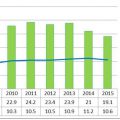
Work Incentives (Updated)
11 Nov 2015Introduction
A key aim of public policy is to ensure that work pays while achieving adequate income protection for the unemployed. This is particularly important in the case of young people in order to avoid locking them into long-term unemployment which has very negative economic and social consequences in the longer-term.
What does the data tell us about how we reconcile the need to provide adequate social protection with that of ensuring that disincentives to enter or rejoin the labour market are minimised? The EU Commission has published very useful data on this question1 .
Labour Market Performance
The employment rate of low-skilled workers2 in 2014 was as follows
Ireland 45.9%
EU 28 53.7 %
Ireland ranking 21
We are one of the poorer performing EU Members states on this measure. So we have a problem in that less than half of our low-skilled workers are employed.
Definitions
Economically inactive people are those who are not in work, but who do not satisfy all the criteria for unemployment under the International Labour Organisation (ILO) convention (wanting a job, seeking a job in the last four weeks and available to start work in the next two), such as those in retirement and those who are not actively seeking work. Unemployed people are those who meet the ILO criteria.
Work Incentives
The EU report uses two measures to assess work incentives. These are the inactivity trap3 and the unemployment trap4 . The data is as follows
Inactivity Trap for Single People 2013
50% Average Wage 67% Average Wage
Ireland 86.3% 75.3%
EU 28 61.9 % 56.5 %
Ireland’s Ranking (of 27) 25 25
Only Denmark and Netherlands are worse
Unemployment Trap for Single People 2013
50% Average Wage 67% Average Wage
Ireland 85.3% 74.5%
EU 28 79.9% 74.8%
Ireland’s Ranking (of 27) 19 11
The contribution of the tax system to these implicit marginal tax rates is 3% in the case of the inactivity trap and 2 % for the unemployment trap at the 50% level and about 13% for the inactivity trap and 12 % for the unemployment trap at the 67 % level; this suggests that the problem seems to be arising mainly from the loss of benefits.
Such high effective marginal tax rates are at levels that would be unacceptable if applied to those at the top of the income distribution; why is this not the case at the other end of the income distribution ?
Second Earners
Second earners sometimes face specific disincentives to returning to work from inactivity or to increasing the number of hours worked. Such disincentives usually arise from the tax system but loss of benefits can also play a role.
The employment rate (used as a proxy for second earners) is as follows
Employment of Women 201
Employment Rate
Ireland 61.2%
EU 28 65.6%
Ireland ranking of 28 19
Note : Employment rate is for age group 25-64.
Disincentives to Work 2013
Inactivity Trap Low-Wage Trap
Ireland 29.5% 33.6
EU 28 32.0% 37.4
Ireland ranking of 27 7 16
Note : The inactivity trap is for second earner in a two earner couple with two children; principal earner with 67 % of average wage , second earner with 67 % of average wage.
The low-wage trap is for second earner in a two earner couple with two children; principal earner with 100 % of average wage, second earner moving from 33% to 67 % of average wage.
In Ireland one-third of the disincentive is due to the tax system.
Conclusion
Based on this data the disincentives to work for young people with low skills are high and need to be reduced. While the issue is clear, it is less obvious what to do about it. One route, not likely to be acceptable is to reduce benefits. Another is to extend the earnings taper. This looks more attractive but it pushes the traps further up the earnings distribution and is more costly. Another option is to make an in-work benefit like Family Income Supplement more generous and increase the take-up rate.
Notes:
1 Tax Reforms in EU Member States 2015, European Economy, Institutional paper 008. September 2015
2 Low-Skilled workers are those aged 20-64, with only pre-primary, primary or lower secondary education.
3 Inactivity trap refers to the disincentive to return to employment after inactivity. The inactivity trap is also often referred to as the participation tax rate and refers to the part of the additional gross wage that is taxed away in the form of increased taxes (personal income tax, employee social insurance contributions) and withdrawn benefits such as unemployment benefits, social assistance and housing benefits in the event of an inactive person taking up a job.
4 Unemployment trap refers to the disincentive to return to employment from unemployment. It measures the part of the additional gross wage that is taxed away when a person returns to work from unemployment. It takes into account the reduction in benefit payments following the return to the labour market, as well as higher taxes and social insurance contributions.





